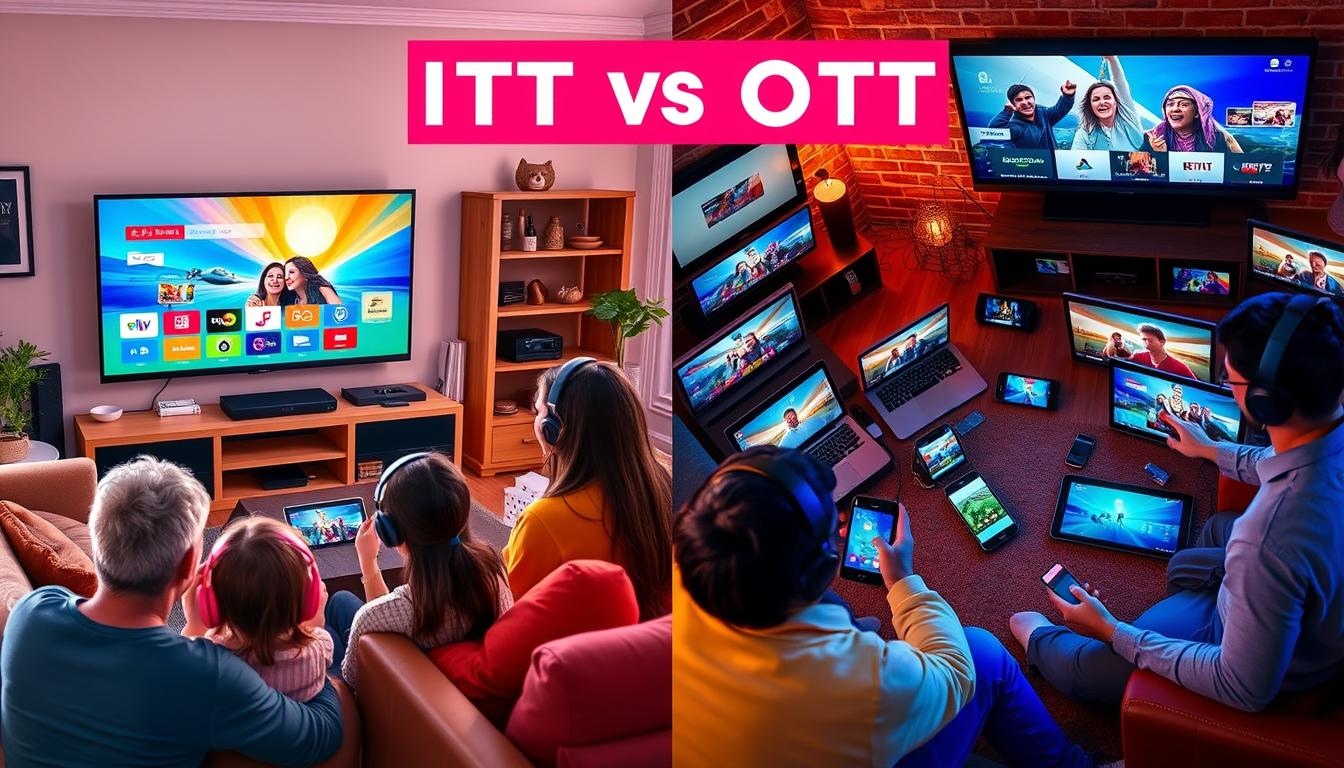
Is IPTV better than OTT streaming? – Streaming Guide 2024
The world of digital entertainment is always changing. This has made the debate between IPTV and OTT streaming very popular in Canada. This guide will look closely at both, focusing on their technical features, content, and how users experience them. We aim to help you choose the best for your entertainment needs in 2024.
Key Takeaways
- Understand the fundamental differences between IPTV and OTT streaming services
- Explore the technical infrastructure and content delivery architectures of both platforms
- Compare video quality and streaming performance to identify the optimal choice
- Examine the cost-benefit analysis, user experience factors, and content availability
- Discover the unique subscription models, pricing structures, and device compatibility
Understanding IPTV and OTT Streaming Fundamentals
Two streaming technologies have grown in the digital world: IPTV and OTT streaming. Knowing how they work helps decide if IPTV or OTT streaming is best for Canadians.
What Makes IPTV Different from Traditional Broadcasting
IPTV sends TV content over the internet, not through old TV systems. It lets viewers pause, rewind, and watch shows on demand. IPTV can also offer better picture quality and needs more bandwidth than traditional TV.
Core Components of OTT Streaming Services
OTT streaming sends video over the internet, skipping traditional TV providers. Services like Netflix and Amazon Prime Video let you watch a lot of content on many devices. Their success comes from offering flexible content and working well with popular devices.
Technical Infrastructure Requirements
- IPTV needs a special IP network for reliable streaming and low latency.
- OTT services use the public internet. They need good bandwidth management and CDNs for high-quality streaming.
It’s important to know the main differences between IPTV and OTT streaming. This helps figure out which one is better for Canadian viewers.
The Evolution of Streaming Technology in Canada
Canada has seen a big change in streaming technology over the last ten years. It started with internet protocol television (IPTV) and then moved to over-the-top (OTT) media services. Now, viewers have many streaming options to choose from.
In the early 2000s, IPTV services came to Canada. They offered a new way to watch TV, different from cable and satellite. Services like Bell Fibe TV and TELUS Optik TV gave viewers a more interactive experience. They used internet protocol technology to stream high-quality video.
As time went on, OTT streaming platforms like Netflix and Crave changed how Canadians watch media. These services deliver content straight to viewers over the internet. They have become very popular, offering lots of movies, TV shows, and original content.
The growth of OTT streaming in Canada has also made video quality better. Providers have worked hard to improve their technology. This has made watching TV online more enjoyable and clear.
Now, IPTV and OTT streaming in Canada are competing with each other. They all want to give the best content and experience to their customers. As technology keeps getting better, streaming in Canada will keep changing. It will meet the needs and wants of viewers in the country.
“The rise of OTT streaming has fundamentally transformed the way Canadians consume media, offering unprecedented access to a world of entertainment at their fingertips.”
Content Delivery Networks: IPTV vs. OTT Architecture
When it comes to streaming video in Canada, the setup of IPTV and OTT services matters a lot. It affects how well and reliably you can watch your favorite shows. Let’s look at what makes these two different.
Network Infrastructure and Scalability
IPTV uses its own network, which the service provider controls. This means they can manage the bandwidth better. So, you get a steady stream, even when lots of people are watching.
But, OTT services use the public internet. This can cause problems like slow speeds and dropped connections. It might make your stream choppy or stop working.
Bandwidth Management Systems
IPTV has special systems to manage bandwidth. They make sure your video stream is top-notch. These systems adjust the stream’s quality based on your internet speed.
OTT services don’t have as much control over the network. They use smart streaming tech to try and keep the stream smooth. But, it might not work as well as IPTV’s systems.
Server Distribution Models
IPTV has a central server setup. The service provider controls the servers and the content. This makes it easier to manage subscriptions and licensing.
It also helps them grow their system as more people join. OTT services use a network of servers all over the place. This makes the stream faster and more reliable for you.
Knowing how IPTV and OTT systems work helps Canadians choose the best streaming service for them. It’s all about what you value most in your streaming experience.
Video Quality and Streaming Performance Comparison
When it comes to streaming video quality, IPTV and OTT services have their own strengths. IPTV offers a stable viewing experience thanks to its managed network. OTT platforms, on the other hand, provide more flexibility and work on more devices.
Bandwidth requirements play a big role in video quality. IPTV uses multicast technology to send high-quality video streams efficiently. OTT services can face buffering and delays, especially during busy times or with poor internet.
| Metric | IPTV | OTT Streaming |
|---|---|---|
| Typical Resolution | 1080p or higher | 720p to 1080p |
| Average Bitrate | 8-15 Mbps | 3-8 Mbps |
| Buffering Frequency | Rare | More common |
The table shows the main differences in streaming video quality between IPTV and OTT services. IPTV still leads in consistent video quality and fewer buffering issues.
“IPTV’s managed network infrastructure allows for superior video quality and streaming performance compared to the open-internet nature of OTT platforms.”
The choice between IPTV and OTT streaming depends on what matters most to you. This includes video quality, internet reliability, and the content available.
Is IPTV better than OTT streaming?
Canadian viewers have a choice between IPTV and OTT services for streaming media. Both have their own benefits. Let’s look at cost, user experience, and content to help you decide.
Cost-Benefit Analysis
IPTV might cost more upfront for hardware and installation. But, it offers a stable connection. OTT streaming is cheaper, needing only a device and internet. Yet, streaming quality depends on your internet.
User Experience Factors
IPTV gives a TV-like experience with live pausing and recording. OTT services are easier to use, helping you find your favorite shows.
Content Availability Comparison
IPTV has more channels and live programming. OTT services have more on-demand content, including exclusive titles. Content availability depends on your location and plan.
Choosing between IPTV and OTT streaming depends on your needs. Consider cost, user experience, and content to find the best for you in Canada.
Content Libraries and Licensing Differences
In the streaming world, content libraries and licensing agreements between IPTV and OTT services are key. In Canada, these differences are important for users to know. They help understand content licensing, Is IPTV better than OTT streaming?, and over-the-top media services.
IPTV, or Internet Protocol Television, has a more selected content library. Providers often have special deals with content makers. This means a steady and reliable choice of shows, movies, and live TV channels. But, it might mean less variety compared to OTT platforms.
OTT services, like Netflix, Amazon Prime Video, and Disney+, have a broader and changing content library. They make deals that let them offer more content, including both hits and special finds. But, what’s available can change as deals shift.
| Feature | IPTV | OTT Streaming |
|---|---|---|
| Content Library | Curated and controlled, with exclusive licensing agreements | Diverse and dynamic, with non-exclusive licensing deals |
| Content Availability | Consistent and reliable selection of shows, movies, and live TV channels | Wider variety of content, but availability can be more fluid |
| Regional Restrictions | Content may be limited to specific regions or markets | More global reach, but still subject to regional licensing restrictions |
The choice between IPTV and OTT services in Canada depends on what you want. It’s about the content you like, how much you value exclusivity, and where you can watch it.
Subscription Models and Pricing Structures
In Canada, the demand for IPTV and OTT streaming services is rising. This has led to a variety of subscription models and pricing structures. Consumers now have many options, each with its own features and prices.
IPTV Service Plans
IPTV providers in Canada offer different subscription models. You can find everything from basic packages to premium plans with lots of content. Many services also let you bundle with internet and phone, making it easier to manage your bills.
OTT Platform Subscriptions
The over-the-top media services in Canada are also diverse. You can choose from free services with ads to premium on-demand subscriptions. This variety caters to different tastes and budgets.
Bundle Options and Deals
Both IPTV and OTT providers in Canada offer bundle options and promotional deals. These deals can include discounts, extra content, or even other services. They help consumers find great value for their entertainment.
Understanding IPTV and OTT subscription models and pricing structures helps Canadian viewers make better choices. They can pick the service that suits their viewing habits and budget.
“The evolution of streaming technology has empowered consumers with more choice than ever before, but navigating the various subscription options can be a challenge. By comparing the features and pricing of IPTV and OTT services, viewers can find the perfect fit for their entertainment needs.”
Device Compatibility and Access Methods
Device compatibility and access methods are key for a good streaming experience. Whether you choose IPTV or OTT streaming, knowing which devices work is crucial. This ensures you can watch without any issues.
IPTV works well with many devices like smart TVs, set-top boxes, and mobiles. This means you can enjoy top-notch streaming video quality on your favorite devices. OTT streaming also offers wide access, with apps for smart TVs, streaming devices, phones, and tablets.
Accessibility Across Devices
- IPTV: Compatible with smart TVs, set-top boxes, and mobile apps
- OTT Streaming: Accessible through smart TV apps, streaming devices, web browsers, and mobile apps
Bandwidth Requirements
Both IPTV and OTT streaming need certain internet speeds. IPTV needs a steady, fast connection because it uses a special network. OTT streaming can work with different speeds but might need more for the best streaming video quality.
Choosing between IPTV and OTT streaming depends on what you prefer, the content you want, and your internet and device needs. Knowing these details helps Canadians pick the best streaming option for them.
“The future of TV is not just about the content; it’s about how you access and experience that content.”
Legal Considerations and Regulatory Framework
The world of internet entertainment is growing fast. It’s important to know the laws and rules around content licensing, internet protocol television, and over-the-top media services in Canada. Copyright, content rules, and government policies shape the IPTV and OTT streaming world. They make sure everything is fair and open for both providers and users.
In Canada, laws protect intellectual property rights. They balance the rights of content creators, distributors, and users. There are rules on licensing content, distributing media, and what service providers must do. Knowing these laws is key for IPTV and OTT platforms to stay legal and offer a good service.
The Canadian Radio-television and Telecommunications Commission (CRTC) watches over broadcasting and telecom services, including IPTV and OTT. This group makes sure these services follow content standards, protect consumers, and play fair. This helps create a healthy and competitive space for Canadian viewers and creators.






